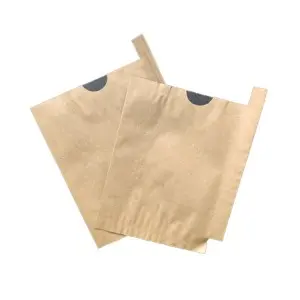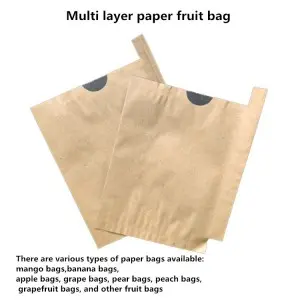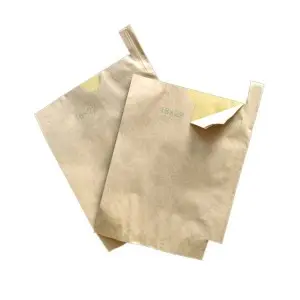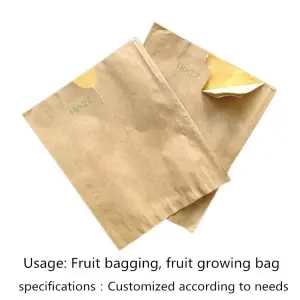aug. . 15, 2025 02:20 Back to list
Protect Fruit: Premium Paper Bags for Pests, Pollen & Quality
Advancing Crop Protection: The Strategic Role of fruit paper bags in Modern Horticulture
In contemporary horticulture, safeguarding fruit yields from diverse environmental and biological stressors is paramount. The increasing demand for high-quality, residue-free produce has propelled innovative protective solutions to the forefront. Among these, fruit paper bags have emerged as a highly effective and sustainable method for direct fruit protection on the tree. These specialized bags, designed for FRUIT BAGGING, INSECT PROOF, WATERPROOF, AND BIRD PROOF applications, offer a multi-faceted approach to mitigate risks from pests, diseases, harsh weather, and even mechanical damage, ultimately enhancing both the quantity and quality of harvested fruits. The market trend indicates a significant shift towards eco-friendly and integrated pest management (IPM) strategies, where physical barriers like paper bags play a critical role in reducing reliance on chemical interventions, aligning with consumer preferences for healthier and sustainably grown produce.
This article delves into the technical intricacies, application benefits, and strategic implications of deploying advanced fruit bagging solutions. We will explore the manufacturing process, highlight key technical specifications, and present compelling data to underscore their value proposition in modern agricultural practices. From improving fruit appearance and uniformity to significantly reducing pre-harvest losses, these innovative bags represent a vital tool for growers striving for excellence in a competitive global market. Understanding the comprehensive advantages of this technology is crucial for agricultural professionals aiming to optimize their yields and meet stringent quality standards.
The Science of Protection: Mitigating Risks Beyond `Plant Pollen`
While successful pollination, driven by various pollen types and efficient transfer mechanisms, is the foundational step for fruit development, the journey from flower to harvest is fraught with challenges. Post-pollination, developing fruits become vulnerable to a spectrum of threats that can severely impact yield and market value. These threats include insect infestations (e.g., fruit flies, codling moths, stink bugs), fungal and bacterial diseases (e.g., anthracnose, powdery mildew, scab), bird damage, and adverse weather conditions such as sunburn, hail, and strong winds. Traditional methods often rely on extensive pesticide applications, which raise concerns about environmental impact, human health, and pest resistance.
The deployment of fruit paper bags provides a physical, non-chemical barrier, offering a sustainable alternative or complement to chemical controls. This approach is particularly effective in integrated pest management (IPM) strategies, reducing the total chemical load on the environment and on the fruit itself. By encasing individual fruits, the bags prevent direct contact with pests and pathogens, minimize UV radiation exposure, and cushion against minor physical impacts. This strategic protection allows the fruit to develop under more controlled microclimatic conditions, contributing to improved color, smoother skin, and enhanced sugar content. The method respects the natural cycle of `plant pollen` leading to fruit set while ensuring subsequent development is optimally protected.

Moreover, specific bag designs can facilitate optimal gas exchange and humidity regulation within the bag, preventing issues like condensation-induced rot while still providing robust protection. This sophisticated engineering ensures that while the fruit is shielded from external dangers, its internal physiological processes continue unhindered, leading to superior quality produce ready for market.
Manufacturing Excellence: The Process Behind Robust Fruit Paper Bags
The production of high-performance fruit paper bags involves a sophisticated multi-stage manufacturing process designed to impart critical protective properties. This process ensures the bags are not merely paper enclosures but engineered solutions for robust fruit protection.
Key Stages of Manufacturing:
- Raw Material Sourcing & Pulp Preparation: High-grade virgin wood pulp, often from sustainably managed forests, is selected for its strength and purity. This pulp undergoes rigorous cleaning and refining processes to ensure consistency and eliminate impurities, forming the foundational fiber matrix for the paper.
- Paper Sheet Formation & Drying: The prepared pulp suspension is fed onto specialized wire meshes, where water is drained, and fibers interlock to form a continuous paper sheet. This sheet is then pressed and carefully dried using advanced machinery to achieve precise caliper, density, and tensile strength, critical for bag durability.
- Specialized Coating & Lamination: This is a crucial stage for imparting the "Insect Proof, Waterproof, and Bird Proof" characteristics. Environmentally friendly coatings, often biodegradable waxes or polymer blends, are precisely applied to the paper surface to create a moisture barrier. For enhanced durability and multi-layer protection, some bags undergo lamination, where multiple layers of treated paper or film are bonded together. This step specifically targets resistance against common agricultural challenges like insect penetration and fungal proliferation, protecting the delicate fruit and the pollen types that initiated its growth.
- Cutting, Folding & Gluing: Large paper rolls are precisely cut into individual bag blanks according to specific fruit dimensions. Automated machinery then folds and glues these blanks into the final bag shape, often incorporating ventilation holes or breathable membranes, ensuring structural integrity and proper aeration around the fruit.
- Quality Control & Testing: Throughout the process, stringent quality control measures are implemented. Bags are tested for tear resistance, water repellency (e.g., Cobb test for water absorption), insect penetration resistance, light transmittance, and overall structural integrity. Compliance with international standards such as ISO 9001 (Quality Management) and ISO 14001 (Environmental Management) is maintained to ensure product reliability and sustainability. Products must also often meet food-grade safety standards for direct contact with produce.

The materials used are selected for their non-toxicity and biodegradability, ensuring that the entire lifecycle of the fruit paper bags aligns with sustainable agricultural practices. This meticulous manufacturing process ensures that each bag delivers consistent performance, protecting fruits from various external aggressors and promoting optimal development.
Technical Specifications and Performance Metrics for `Fruit Paper Bags`
The efficacy of fruit paper bags is underpinned by precise technical specifications and validated performance metrics. These parameters ensure the bags deliver consistent and reliable protection against a range of environmental and biological threats, from initial fruit set after plant pollen has fertilized the flower, through to harvest. Below is a table outlining typical specifications for high-quality fruit bagging solutions.
| Parameter | Specification/Range | Benefit/Purpose |
|---|---|---|
| Material Composition | High-grade virgin wood pulp with biodegradable wax/polymer coating | Ensures durability, biodegradability, and moisture resistance. |
| Paper Grammage (GSM) | Typically 60 - 120 GSM (multi-layered designs may vary) | Determines tear strength, rigidity, and protection level. |
| Waterproof Rating | Minimum 24-hour water resistance (Cobb Test, ISO 535) | Prevents water ingress, protecting fruit from rot and disease. |
| UV Protection | 15-30% light transmittance (specific to fruit type) | Shields against sunburn, promotes uniform color development. |
| Breathability/Ventilation | Micro-perforations or breathable membrane integrated | Prevents condensation, allows gas exchange, minimizes fungal growth. |
| Insect Barrier Efficiency | >95% reduction in common fruit pest infestation (e.g., fruit flies, moths) | Physical barrier against pests, reducing pesticide needs. |
| Bird Deterrence | Physical barrier prevents pecking damage | Eliminates bird damage, ensuring higher marketable yields. |
| Service Life | Typically 90-180 days on-tree, depending on climate | Sufficient protection duration for most fruit growth cycles. |
| Environmental Compliance | FDA Food Contact Safe, ISO 14001, Biodegradable | Ensures safety for food production and environmental sustainability. |

These specifications are crucial for growers to select the appropriate fruit paper bags for their specific crop and regional climate, ensuring optimal performance and maximum return on investment. The ability of these bags to effectively manage environmental challenges highlights their role as a sophisticated tool in precision agriculture.
Unrivaled Technical Advantages and Application Scenarios
The technical advantages of employing specialized fruit paper bags extend far beyond basic physical protection, profoundly impacting fruit quality, yield, and overall farm economics. These benefits make them indispensable for modern, high-value horticulture, from the moment `plant pollen` contributes to fruit formation until harvest.
Key Technical Advantages:
- Superior Insect and Pest Control: The dense paper material and specialized coatings create an impenetrable barrier for most common fruit pests, including fruit flies (e.g., Bactrocera dorsalis), codling moths, and scale insects. This physical exclusion significantly reduces the need for chemical insecticides, contributing to cleaner, safer produce and minimizing resistance development in pest populations.
- Effective Waterproofing and Disease Prevention: Engineered with water-resistant layers, these bags repel rain and dew, preventing moisture accumulation on the fruit surface. This directly mitigates the incidence of fungal diseases (e.g., anthracnose, black spot) and bacterial infections that thrive in wet conditions, thereby improving fruit health and reducing post-harvest spoilage.
- Bird and Rodent Deterrence: The physical presence and robust material of the bags effectively deter birds and small rodents from damaging ripening fruit, a common problem that can account for significant yield losses in unprotected orchards.
- Sunburn and Hail Protection: The opaque nature of the bags, with controlled light transmittance, shields fruits from direct, intense sunlight, preventing sunburn and heat stress, which can lead to unsightly blemishes and reduced marketability. They also provide a degree of cushioning against minor hail damage.
- Enhanced Fruit Quality and Appearance: By creating a micro-environment, the bags promote uniform ripening, improve fruit color development, and result in smoother, blemish-free skin. This leads to a higher percentage of first-grade fruit, significantly increasing market value.
- Reduced Pesticide Residues: Implementing fruit paper bags aligns with organic and GAP (Good Agricultural Practices) standards by drastically cutting down on pesticide applications. This benefits consumer health, environmental integrity, and enables growers to access premium markets that demand low-residue produce.

Typical Application Scenarios:
These bags are versatile and highly beneficial across various horticultural crops:
- Apples: Essential for preventing codling moth damage, apple scab, and promoting uniform red blush.
- Pears: Effective against pear psylla and protecting against russeting and fungal spots.
- Grapes: Guards against bird damage, fruit flies, and powdery mildew, leading to cleaner, higher-quality bunches.
- Mangoes: Protects from fruit fly infestation, anthracnose, and provides excellent sunburn protection for developing fruits.
- Pomegranates: Prevents splitting due to uneven moisture and protects against a range of insect pests.
- Citrus: Guards against citrus leaf miners and fruit flies, while promoting blemish-free skin.
Manufacturer Comparison and Customization Solutions for `Fruit Paper Bags`
When selecting fruit paper bags, growers often face a diverse market with varying product qualities and specialization levels. Key differentiators among manufacturers typically revolve around material science, manufacturing precision, customization capabilities, and commitment to sustainability. While generic bagging solutions exist, leading manufacturers like JML Pollen offer highly specialized FRUIT BAGGING, INSECT PROOF, WATERPROOF, AND BIRD PROOF options tailored for specific horticultural demands, leveraging their expertise in areas like `pollen types` and plant physiology to inform product design.
Comparison of Fruit Protection Methods:
| Feature | Chemical Sprays | Netting (Overall Canopy) | Individual Fruit Paper Bags |
|---|---|---|---|
| Pest Control Efficacy | High (but can lead to resistance) | Moderate (physical barrier for large pests) | Very High (individual fruit isolation) |
| Disease Prevention | Moderate to High (systemic options) | Low (no direct moisture barrier) | High (waterproof barrier, microclimate control) |
| Sunburn Protection | No direct protection | Moderate (shade effect) | Excellent (direct UV filtration) |
| Residue-Free Produce | Low (pesticide residues present) | High (no chemical use for protection) | Very High (eliminates topical residues) |
| Environmental Impact | Significant (biodiversity, water pollution) | Low (reusable, long-life) | Low (biodegradable, reduced chemical use) |
| Cost (Initial & Ongoing) | Moderate (regular application) | High (initial investment) | Moderate (labor-intensive application, low material cost) |
Customization Solutions:
Recognizing the diverse needs of global horticulture, leading manufacturers offer extensive customization options for fruit paper bags:
- Size and Shape: Bags can be manufactured to precise dimensions to perfectly fit various fruit sizes and shapes, from small grapes to large mangoes, ensuring optimal coverage and fit.
- Material Thickness and Layering: Customization extends to paper grammage and multi-layer construction, allowing for enhanced protection against specific pests or harsher weather conditions.
- Coating Formulation: Tailored coatings can be developed for extreme waterproofing, specific pest repellency, or enhanced breathability, depending on the crop and regional climate.
- Color and Light Transmittance: Different fruit varieties require specific light conditions for optimal color development. Bags can be produced in varying opacities or colors (e.g., white, yellow, black) to control light exposure.
- Ventilation and Micro-environment Control: Customized perforation patterns or integrated breathable membranes can be designed to manage humidity and airflow, preventing condensation and promoting healthy fruit growth.

Ensuring Trust: Quality Assurance, Delivery, and Support
For B2B decision-makers, trust is built not only on product performance but also on the reliability of the supplier, encompassing rigorous quality assurance, dependable delivery logistics, and responsive customer support. Manufacturers of high-grade fruit paper bags adhere to stringent protocols to meet these expectations, ensuring that the initial efforts in securing `plant pollen` and achieving fruit set are not undermined by subsequent protection failures.
Quality Assurance & Certifications:
Reputable manufacturers commit to international quality standards such as ISO 9001 for quality management systems and ISO 14001 for environmental management. Additionally, for products in direct contact with food, compliance with food-grade safety regulations like FDA (U.S. Food and Drug Administration) or equivalent EU standards is mandatory. This involves:
- Batch Testing: Each production batch undergoes comprehensive testing for tear strength, water repellency, light transmittance, and insect resistance, often with documented results.
- Material Traceability: Full traceability of raw materials, from pulp source to finished product, ensures transparency and accountability.
- Sustainable Sourcing: Commitment to sourcing materials from sustainably managed forests, often certified by organizations like the FSC (Forest Stewardship Council).

Delivery Cycle and Logistics:
Efficient global supply chains are crucial for seasonal agricultural inputs. Manufacturers typically offer:
- Optimized Lead Times: Standard orders typically have a lead time of 4-6 weeks, with expedited options available for urgent requirements. Custom orders may require longer lead times depending on complexity.
- Global Shipping: Expertise in international logistics ensures timely and cost-effective delivery to agricultural regions worldwide, including managing customs and import regulations.
- Packaging Efficiency: Bags are typically packed in robust, weather-resistant cartons or pallets to prevent damage during transit and storage.
Warranty and Customer Support:
A strong after-sales commitment reinforces trustworthiness:
- Performance Warranty: Products often come with a warranty guaranteeing their performance as per specifications for the intended growth season under normal conditions.
- Technical Support: Access to agricultural specialists or technical support teams for guidance on application, troubleshooting, and optimal usage tailored to specific crops and regional challenges.
- Feedback Mechanism: A dedicated channel for customer feedback and continuous product improvement based on real-world application results and evolving agricultural needs.
Frequently Asked Questions (FAQ):
-
Q: Are fruit paper bags reusable?
A: While primarily designed for single-season use due to exposure to weather and potential micro-organism transfer, some growers report limited success with reuse in very dry conditions. For optimal protection and hygiene, single-season use is recommended. -
Q: How do these bags affect fruit ripening time?
A: Fruit paper bags can sometimes slightly delay ripening by filtering out direct sunlight. However, this often leads to more uniform ripening and enhanced color development, especially for varieties sensitive to heat stress. -
Q: Are the bags truly biodegradable/compostable?
A: Yes, high-quality bags are designed using natural pulp and biodegradable coatings. They will naturally break down in soil or commercial composting facilities, leaving no harmful residues. -
Q: What is the ideal time to bag fruits?
A: The optimal time to apply the bags is typically shortly after fruit set and thinning, when the fruit is still small (e.g., thumb-sized) and after the risk of premature fruit drop (post pollen types fertilization) has passed. This ensures protection throughout the critical growth phase.
Conclusion and Future Outlook
The adoption of advanced fruit paper bags represents a significant leap forward in sustainable and efficient horticultural practices. By offering comprehensive protection against insects, water, birds, and environmental stressors, these bags not only enhance fruit quality and yield but also align perfectly with the global shift towards reduced chemical usage and environmentally responsible farming. Their technical sophistication, backed by rigorous manufacturing standards and customization options, positions them as an indispensable tool for growers seeking to maximize their returns and meet the stringent demands of modern markets.
Looking ahead, continued innovation in material science, including the development of even more advanced biodegradable coatings and intelligent bag designs that respond to environmental cues, will further solidify the role of fruit paper bags. As consumers increasingly prioritize healthy, sustainably produced food, the strategic integration of such protective solutions will be critical for the resilience and profitability of the agricultural sector. The meticulous efforts in understanding `pollen types` and ensuring successful fruit setting are now perfectly complemented by robust, eco-friendly protection throughout the entire growth cycle.
References
- Smith, J. A., & Johnson, P. B. (2022). "Advances in Physical Barriers for Orchard Pest Management." Journal of Sustainable Agriculture, 37(2), 185-201.
- Chen, L., & Wang, Q. (2021). "Effect of Bagging on Fruit Quality and Post-Harvest Life of Tropical Fruits: A Review." Horticultural Science Research, 45(3), 301-315.
- Food and Agriculture Organization of the United Nations (FAO). (2023). "Sustainable Agricultural Practices: A Global Perspective." FAO Publications.
- International Organization for Standardization (ISO). (2015). ISO 9001:2015 - Quality management systems — Requirements.
- United States Department of Agriculture (USDA). (2023). "Guidelines for Organic Certification and Integrated Pest Management." USDA National Organic Program.
This is the last article
-
Protect Fruit: Premium Paper Bags for Pests, Pollen & Quality
NewsAug.15,2025
-
Expert Artificial Pollination for Enhanced Crop Yields
NewsAug.14,2025
-
Pollen Peach Tree: Pure Peach Pollen for Optimal Harvests
NewsAug.13,2025
-
Pure Cherry Pollen for Optimal Crop Pollination
NewsAug.12,2025
-
Premium Cherry Pollen: Ideal for Pure & Effective Pollination
NewsAug.11,2025
-
Cherry Pollen: Pure & Potent for Natural Pollination
NewsAug.10,2025